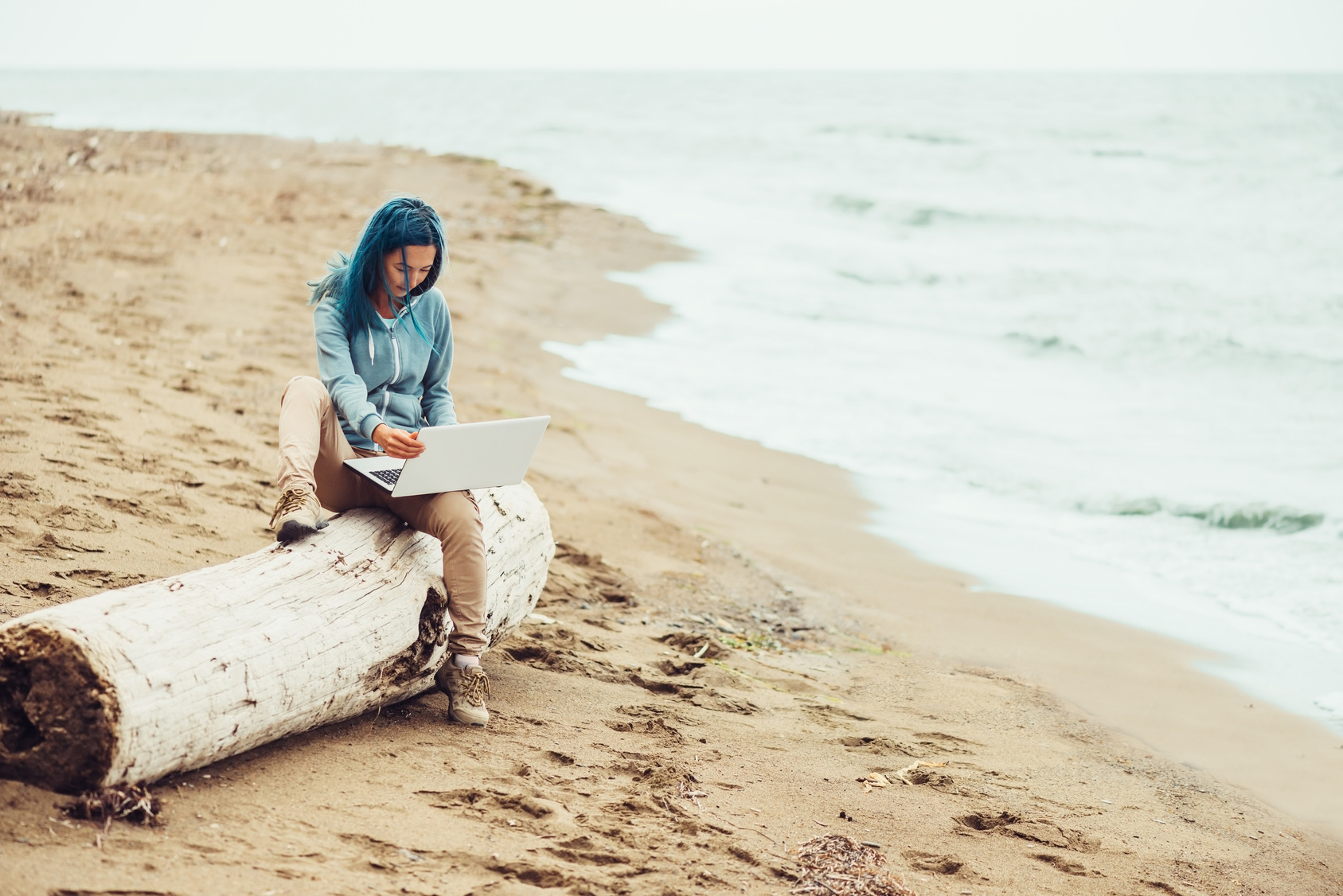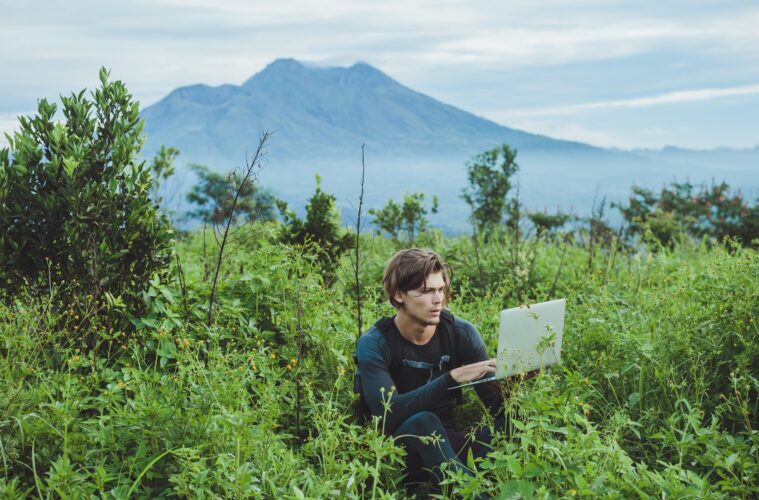Tamara Sword is cofounder of Infltr, an innovative photography app with more than five million filters. Here she discusses the future of digital nomads, in a world where work, travel and technology are enabling a new kind of coexistence.
It’s coming up to ten years since the introduction of the first iPhone and the beginning of the smartphone revolution. Ten long years and the early promise that these devices would free us from the grey daily commute and office banter finally seems to be coming true.
In the US today, 30 per cent of workers are freelance. By 2035, it’s predicted this will rise to more than 50 per cent.
A new generation of workers – digital nomads – are harnessing the power of mobile and Instagramming their way to a new kind of productivity; free from employers, property, belongings and maybe even stress.
There are now two distinct tribes within our society. There are the “digital nomads” whose work follows them around the world, and the “digital settlers” whose work follows them home.
Before we get into what it is to be a digital nomad, let’s spare a thought for the digital settlers, those still working in an office – that caffeinated bastion of internecine politics, strip lighting and bad backs.
Dissatisfaction with the modern office is at an all time high. No wonder. Real wages in the UK fell every year between 2009 and 2014 – a decline that hasn’t happened since the Victorian era. And research is finally proving something we all intuitively knew to be true: open plan offices make us more stressed, less happy, less productive and more sick.
Office work of course didn’t used to be this way. I am just about old enough to remember the halcyon days of private offices thick with smoke, three hour lunches and the rattle of the drinks trolley at 4pm. An individual wage packet that could support an entire family.
But those days are long gone. The nineties and early noughties saw a corporate cultural revolution sweep our working environments – our office walls torn down in favour of a more efficient, more egalitarian use of space.
Companies drafted in Change Management gurus to deal with the emotional and psychological trauma employees inevitably suffered when “going open plan”.
It seems to me a rather eerie coincidence that just as the internet put infinite information at the finger tips of employees, privacy at the office was eliminated. But at what cost to our mental health, our productivity and our wellbeing?
The Scandinavian Journal of Work, Environment and Health found people who work in open plan offices take 62 per cent more sick days than people with their own personal space.
Research in 2014 by IPSOS surveyed more than 10,000 office workers across 14 countries – on average they lost 86 minutes each per day to office “distractions”. Distractions like whose turn is it to make the coffee? The background noise of the photocopier. Gary from accounts.
Earphones quickly became the new office walls.
In the US, resentment and frustration seem to be reaching critical mass – 5.5 per cent of all US workplace deaths are suicides… at their place of work.
Against this backdrop of an increasingly inhospitable working environment, it’s little wonder so many people are choosing to work freelance or work remote. The internet allows us to work wherever we lay our hat – providing there’s good wifi.
The value we used to place on face to face communication has been steadily eroded by ersatz communication via Facetime and Skype. Our family relationships have become increasingly distributed, so why shouldn’t our working relationships?
It’s becoming harder and harder for companies to justify a culture of “presenteeism”.
Attracting and retaining talent has become a major challenge for knowledge intensive businesses. Many have introduced the “sabbatical” – work five years and get three months off for good behaviour is a common ratio that keeps employees locked in, focused on the light at the end of the tunnel.
Other companies – especially cash rich and talent hungry tech companies – are responding by creating offices so well equipped that employees never need to go home. Fitness centres, in house masseurs, paleo cafeterias, climbing walls, nap rooms. These are offices that could pass as members’ clubs.
And yet, the very people these companies rely on are increasingly difficult to pin down. It’s no small irony that the very technologies these companies have built, make it ever harder for them to recruit permanent staff.

The digital nomad: in developed nations, global travel has become an inherent part of our self-actualisation and identity.
So when did the digital nomad phenomenon begin? Well, perhaps we can see it’s nomadic roots in the hippy trail of the sixties and seventies, and the rite of passage that inter-railing and gap years were in the eighties and nineties.
The term “digital nomad” itself was first coined in 1997 – the beginning of the internet boom – by a very prescient book by Tsugio Makimoto and David Manners called The Digital Nomad.
Plotting Moore’s Law, Makimoto and Manners forecasted that within ten years, multiple devices would merge into one single, all-powerful communications device. One device to rule them all.
This device, they said, would allow people for the first time to decide whether to be a digital nomad or a digital settler. Exactly ten years later, in 2007, Apple launched the iPhone.
There are now over two billion smartphones in existence. Never has a technology been adopted by so many, so fast.
Making voice calls, of course, is just one of many applications. GPS, accelerometer, audio, video, powerful cameras, touchscreen, bluetooth, finger print scanner. We carry in our pockets technology that, until ten years ago, was the preserve of ad agencies… and the secret service.
It’s an uncomfortable truth, but most of us are addicted to our phones. Chances are it’s the first thing you look at in the morning and the last thing you turn to at night. Your phone is your significant other, your constant companion, the lens through which you see the world and through which the world sees you.
Researchers looked at how people interact with their devices and what they found was staggering. On average, people look at their smartphones 150 times a day. But digging a little deeper into the research, 150 was the average.
Some people looked at their phones an astonishing 900 times a day. That’s pretty much once every waking minute. So in a very real sense we can say that smartphones are wearables – we constantly have them in our hands.

Engaging with these devices is – for many people – not a choice. It is a compulsion. Like Pavlov’s dogs, we jump at every notification. Using a phone is a leading cause of traffic accidents.
Through the smartphone we capture and curate our lived experience, exchanging it for likes, shares, follows and retweets. The more exotic the experience, the greater the engagement. Thanks to the smartphone, we are no longer consumers. We’re all brands now, hungry for engagement, and the selfie is our logo.
Empowered by these devices, our sense of the real seems to be mutating. We feel compelled to capture the significant moments of our lives and pin them like dead butterflies to our social walls. It is no longer enough to experience life, we must be seen to experience it. Snapchat or it didn’t happen.
Even our relationship to place is being made anew. In many ways, London today feels closer to Shanghai or San Francisco than it does to Newcastle or Birmingham. The world’s mega cities increasingly share the same culture, the same company headquarters, the same infrastructure challenges… and the same people.
A growing tribe who join the dots on the world map with their flight paths – a creative class flitting between cities and scenic retreats, their digital skills ever in demand wherever they go. Belonging everywhere and nowhere at the same time; united less by their places of origin than by their choice of operating system.
Why are so many people – specifically millennials – choosing to be digital nomads?
Yes, thanks to the internet, business has become distributed – we’re more able to work remote than ever before. But I don’t think we can ignore the fact that unlike their parents and grandparents, millennials in the developed world are facing falling not rising standards of living.
Rather than rebel, Generation Rent seems to shrug like Atlas at the ever more remote possibility of home ownership – as it drifts away on a rising tide of student debt and gentrified house prices.

The digital nomad: make a living from your Instagram feed, documenting your #digitalnomad #life #livingthedream.
Instead, they take advantage of the ever decreasing cost of flights. Why buy a car when you can Uber? Why cook when you can Just Eat? Why commit when you can Tinder? Why work when you can vlog?
With every increase in internet speed and connectivity, the world gets smaller and new experiences more curatable. You can hot desk from base camp at Everest. Run a global online retail business from an Ayahuasca retreat in the rainforest.
Early humans were nomadic. Perhaps it’s our natural state and the rise of the digital nomad our millennial return. Equipped with the defining tool of our age – the smartphone – many are choosing to leave behind ten thousand years of materialism in favour of joining this new tribe: hunter gatherers of experience not things.
In a culture increasingly driven by social engagement, having “experiences” is becoming more important than owning material things. Experiences after all make for better photographs. Pieter Levels is maker of Nomad List, a site that lets nomads find the best places to live, work and meet.
He sees Experientialism as one of the big reasons the digital nomad trend is taking off. Levels says: “People today want to explore the world and meet people from different cultures. Just an IKEA table and a TV isn’t going to cut it any longer.”
Digital nomads fall into two main groups. Those who work digitally – most commonly designers and developers – and people running digital businesses.
And then there’s a smaller group who document their life on the road – making a living online from sharing their aspirational life style – presumably for digital settlers to consume.
The common perception of the digital nomad is not formed by the quiet majority – the coders and copywriters beavering away on their laptops albeit in flip flops and with a cold beer to hand.
No – the archetypal digital nomad is the one we see endlessly plugged on social.
The nauseating couple travelling the world equipped with just their model good looks and a selfie stick. Then there’s that guy who makes a living on Instagram taking pictures of his girlfriend’s back in exotic locations. The legion of adrenalin junkies – the free climbers and parkour kids – who travel the world, scaling impossible skyscrapers with smartphones in hand.
At the same time, there’s also a veritable publishing bonanza going on, with book titles exhorting this new 21st century gold rush…
The 9 to 5 Escape Artist: A Startup Guide for Aspiring Lifestyle Entrepreneurs and Digital Nomads
The Suitcase Entrepreneur – Creative Freedom in Business and Adventure in Life
Hammocks and Hard Drives – the Tech Guide for Digital Nomads
Live Anywhere, be a Digital Nomad, Work for Yourself!
Backpacker Business: One Girl’s Journey from Wide-Eyed Traveller to Worldwide Entrepreneur
And my favourite, the catchily named:
But the picture on the ground is not always as rose-filtered as it seems on Instagram or as 12-stepped as it appears in print. Levels told me some digital nomads are selling a dream through their social media channels and books because their business relies on it, but it’s not realistic.
As Levels says, “Swimming pools and beaches are fun for awhile, but in the long run they don’t make you happy.” The problem is that people are making rational decisions based on these idealised depictions on social. When they quit their job and start travelling, reality tends to bite within a couple of weeks.
He says being away from family and friends can be challenging – it can be lonely. He told me that we don’t need another cheerleading press article or blog post about how great digital nomads are. Will the press do that? No Pieter says – because the real story doesn’t sell page views.
James Wallman is the author of Stuffocation and founder of think-tank The Future is Here. He points to falling retail spending, increased spending on experiences and the rise of the digital nomad as indicative of a new trend – the end of materialism and the beginning of experientialism.
And yet, if we cease measuring our worth in material things, might yesterday’s status anxiety about what cars we drive or watch we wear be shifting to a new kind of social anxiety – one based on our numbers of likes, follows and retweets?
Before social media, what you did at the weekend was pretty much invisible as a social marker – as James points out. But today, there’s a pressure to display your experience online 24/7 as a way to self express and self promote.
When you see your friends on social having exciting, interesting experiences, what you have in your head – front of mind as advertisers would say – is how to keep up with the Joneses by doing something interesting – not by buying something interesting.
I do believe the decline in materialism is largely true for the majority of people. But there’s no evidence that the 0.1 per cent are giving up materialism anytime soon.
Just look at the Rich Kids of Instagram – yes, they’re documenting their nomadic experiences, but they’re doing it on daddy’s billion dollar yacht, private jet or island. Materialism is alive and well and living in a tax haven.
The cynics among you will point to the carbon emissions of our increased air travel as we search for new experiences, but many people still see digital nomadism as an agent of change.
“I’m amazed at all the fuss over air travel,” Wallman says. “Roughly 5 per cent of carbon emissions are down to travel. That’s absolutely dwarfed by the impact on our planet of global materialism. 95 per cent of all consumer goods six months down the line become rubbish.
Our materialist system is not good at producing consumer goods, it’s good at producing rubbish. Any movement that takes us away from valuing material goods and instead values experiences is environmentally sound – even one based on air travel and Instagram.”
Youjin Do is a film-maker. Her film One Way Ticket is the world’s first documentary about Digital Nomads. She sees a more mobile workforce as relieving some of the pressure on cities, but I find her really interesting because she also considers what impact the Western digital diaspora is having on host nations – many of which are developing economies.
“While making the documentary” Do told me, “I’ve been thinking whether this movement is spreading wealth to developing countries or whether it’s a new form of gentrification”.
Looking at the demographics of the digital nomad tribe, it’s clear the traffic is largely one way. Most digital nomads are from well developed countries and have amazing visa options.
A digital nomad with a European Union passport can for instance get a lot further than a Vietnamese one who faces the very real chance of their visa application getting rejected.
The smartphone may have disrupted the way many people in developing countries live and work, it may even be reshaping our value systems, but global structural inequalities remain largely in tact.
The media endlessly debates whether we should call the millions fleeing war and poverty “economic migrants” or “refugees”. Many carry with them the lifeline of a smartphone or a laptop but no one classes them as digital nomads.
The hashtag is not just about how digital or how nomadic. It is also implicitly about how privileged.
Historically, nomads have always been marked as an Enemy of the State. Persecution, forced resettlement and worse has been and is being meted out to nomads all over the world. Aborigines, Bedouin, Native American Indians, the traveller community here in the UK.
Nomads are difficult to tax. Nomads are difficult to control. Nomads are perceived as dangerous precisely because they show an alternative way to live – a more experiential, and less materialistic way.
But that’s not the case with digital nomads. Governments around the world are competing to attract them. Normal visa restrictions on work rarely apply or are applied. Tax may or may not be being paid in their country of origin. Why does the digital nomad have it so much easier than more traditional nomads?
Is it that digital nomads, while eschewing some aspects of materialism, ultimately conform to accepted standards of productivity in the 21st century? Is it because their unencumbered by the historical prejudice that traditional nomadic communities often face? Or Is it because digital nomadism is usually a temporary “lifestyle”, with many digital nomads likely to “settle down” in the end?
The digital nomad community, let’s not forget, is predominantly young, highly educated, male and child free.
Now, having kids obviously complicates things enormously. Education is slowly becoming more distributed – with online schools and universities popping up which may mean more digital nomads stay nomads if they choose to have children.
Indeed, there have always been parents who have managed to take their children with them around the world – but an itinerant lifestyle is not always a recipe for a happy, stable childhood. That said, the demands of an office job frequently don’t lend themselves to a happy, balanced home life either.
Digital nomadism today isn’t necessarily an either-or choice. More and more people now have the autonomy at work to be able to blend it into their life. It’s the new way – in the tired parlance of women’s magazines – “to have it all”. A career, a family – and an actual life.
This essay was first presented at the Pullman St Pancras hotel in London as part of the chain’s on-going series of expert trend briefings, Pullman Pulse.





